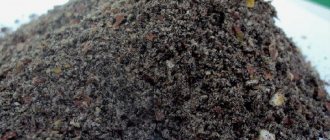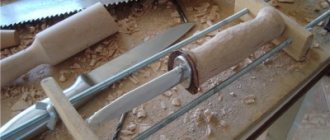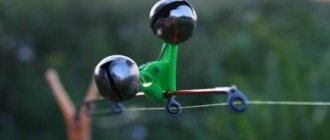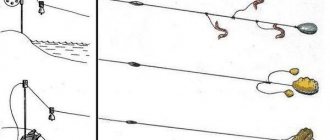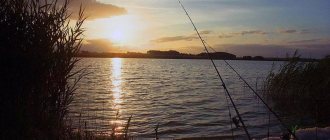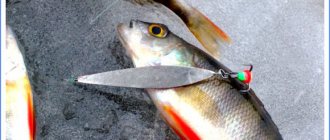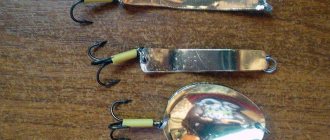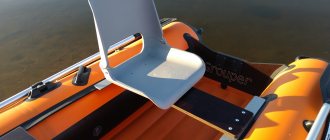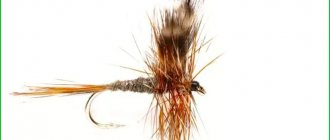A jig is an artificial bait for catching fish. This is a small weight with a certain color and shape with a built-in hook in which there is a hole for fishing line. This device is made of different alloys and metals.
You can attach different types of bait to the jig or do without it (during winter fishing). It is suitable for catching different types of fish (predatory and non-predatory).
Many fishermen, buying jigs in stores, try to remake them at their discretion. Most fishermen make this bait themselves.
What to make your own jigs from?
To make bait at home you will need a minimum number of tools and widely available materials. At home, jigs are usually made of lead (soldered or forged).
The materials can be thin-rolled scraps of ferrous and non-ferrous metals, as well as their alloys. This can be bronze, tungsten (for this you need machines and special tools), tin of coffee cans, cupronickel, stainless steel, coins (royal or made in the 20s).
Gear can be made from any available materials: cans, various types of metal packaging containers (they sell piece and bulk materials). The baits are coated with anti-corrosion material.
Fishermen also use other materials: copper wire, plastic, epoxy resin, stainless steel electrodes. Homemade baits can be
but can be used for all types of fishing (summer, winter).
Casting
Making jigs with your own hands by casting is carried out in two ways. The first involves a complete copy of the existing model, according to which plaster casts are made. The second option involves casting a blank with a hook, and finishing it to the desired shape is done using files, as in the famous joke.
Read specialized literature about how the casting process is organized and carried out!
The manufacturing sequence at the initial stage is approximately the same for both methods:
- A hook is inserted into the plaster mold, or two for a goat or three for a devil.
- The wire is inserted at the desired angle to form a hole in the body.
- The halves of the form are connected and fastened.
- Molten lead is poured through the sprue.
- After complete cooling, the forms are separated.
- The jig is finished with a file.
- The bait is painted or polished.
All popular models are made in this way:
- devils;
- nymphs;
- goats;
- bananas;
- uralochki;
- carnations;
- and many others.
What should you pay attention to when making your own jig?
There are dozens of types of gear, they have many distinctive features. For a novice fisherman, the procedure for selecting certain parameters is the most difficult. It is for this reason that you need to follow some tips for making bait.
Form
When searching for food, fish rely on hearing, smell, touch and vision, which is why when choosing a jig, its shape is important, as it influences good play with the bait.
Every fisherman needs to know how the shape affects the play of the jig; often the fish starts to bite when it is very close to the bottom.
When making gear with your own hands, its shape will play a very important role.
The shape of the jig and its effect on the game:
- If the shape is flat, then it will form small clouds of turbidity and at the same time disperse them;
- Flattened on both sides (top and bottom), capable of raising turbidity and located near the bottom;
- If it has the shape of a pellet or drop, then hitting the bottom it will create fountains of turbidity;
- The “ant” or “Ural” bait does not deviate from the vertical during the game, but their hooks are capable of making turns left and right;
- With a “devil” or “barrel” shape, the bait is immersed in the mud; if the position is vertical, then deviations to the sides are excluded;
- If the jig is in the form of a cone, then at the bottom, it only enters the top layer of silt.
Weight
Types of these gears are divided by weight category, there are light and heavy. In the manufacture of the latter, a hard alloy of metals is used, but this type has a big drawback - they are difficult to process, which is why they are rough in shape, as well as with uneven edges and holes. Because of this, the fishing line may be damaged. A lightweight bait is made of elastic nylon or plastic, its weight does not exceed 35 grams.
Hook
The hook also plays an important role; it must be soldered in very well, otherwise the fish will break off. The best would be a single-bend hook.
When purchasing a set of hooks, the set may contain overheated ones (they will be brittle) and unheated ones (they will be soft). Strength can be determined by pressing the middle of the hook with your fingernail. If the quality is good, then it will bend only with strong pressure.
The tip of the hook should be sharp enough (to ensure strong hooks). To make tackle, it is advisable to use hooks with a forged cross-section; they are many times stronger than similar ones.
Color
Research has proven that any fish can distinguish a range of colors; there are also species that distinguish a greater number of shades than humans. Waterfowl are able to distinguish colors even in the dark. It is for this reason that it is necessary to make bait exactly the same color as the food of this type of fish.
Red is generally preferred due to the fact that many fish feed on bloodworms. You can also make black baits; they look like leeches, bugs and crustaceans. Those feeding on fry will bite on silver or golden bait. If the fish eats algae, the color should be green.
Jig fishing technique
Correctly chosen fishing technique and tactics are the key to success in any fishing.
The first thing you need to start with is to learn how to put on the nozzle correctly and quickly, since in winter it can quickly freeze. The hook of the jig should be very sharp, and its beard should be slightly ground off.
In winter, the jig should be lowered strictly in the middle of the hole and gradually so that the fishing line does not touch or cling to its edges.
Now let's talk about the correct handling of the bait in the water. The fishing result will depend on how the jig is played (amplitude, frequency of oscillations and speed of ascent and descent).
Not only the quality of bites, their quantity, but also the size of the fish caught will depend on the action of the bait itself. It has been noticed that you should not wait for the ruff to bite at the edge of the ice and during fast retrieval, but the perch may not resist.
Perch loves it when the bait moves quickly and with a high oscillation frequency, but the bream prefers smooth oscillations with a leisurely retrieve. With experience comes such quality as moving the jig along its entire length with the same amplitude and speed, and this is 80% of success in fishing.
The technique of fishing with a baitless jig is somewhat different from the technique of fishing with a bait. The nod is made of a more sensitive steel plate. The fishing line must also be appropriate, capable of transmitting the slightest changes in the wiring.
Unattached jigs are generally very light and therefore they are used for fishing at shallow depths (up to 3 m), which means that the caught fish will weigh up to 1 kg. The fishing line must correspond to the maximum weight of the expected fish plus 15%.
The bite with no bait may not be as bright and long-lasting as with bait, so the fisherman must respond by hooking to any change in the retrieve. Of course, this is fraught with snags, but it is also justified by the number of fish caught. This must be done because the fish swallows an almost bare hook, instantly recognizes the deception and instantly spits out the jig. And this happens in fractions of a thousandth of a second.
Manufacturing methods
There are several ways in which gear is made:
- The cutting method is considered the simplest; for this you need to prepare one of the materials: copper, brass, bronze, steel (stainless steel) or silver. Using a metal file or jigsaw, cut out the desired shape. Sand the edges with sandpaper or a fine file. Then you need to take a hook, no larger than 4 in size, and solder it to the workpiece. To add weight to the bait, you need to drop a small amount of lead onto one of its sides.
- If you choose the soldering method, you need to take thin sheets of metal that look like foil. From these sheets you can make the desired shape and insert a hook into the hole, after which you need to solder the result well. To increase weight, you can also drop lead. Using soldering, you can make jigs from wire.
- To make bait from lead, forging is used. Using a hammer and anvil, you need to give the required thickness to the workpiece, then use a file to give it the required shape. You will have to remove the eye from the hook and thoroughly clean the fore-end, treat it with soldering acid and solder it to lead.
- The longest and most difficult method is casting. You need to take two blocks of wood with a flat surface. In both bars you need to make similar holes for jigs so that when connected, you get a single whole. A hook is inserted into the holes and filled with metal.
- You can also upgrade any purchased jig at your discretion. After the bait is ready, you need to proceed to the painting stage, it can be of several types:
- The jig is covered with wax, and so is the hook. The wax must be removed from those parts that will subsequently be blackened. The bait is placed in a glass with a tight plastic lid and put away in a warm place (preferably on a radiator). After a few days, the areas that have been cleared of wax will begin to turn black. When they turn completely black, they need to be immersed in water for a couple of days.
- If you need to paint the jig, you can use any type of enamel paint. Some fishermen also coat the bait with nail polish.
Finishing of finished products
It is customary to modernize summer and winter jigs to increase their catchability. This applies to both homemade products and purchased equipment.
The most common tuning method is changing the shape or flat. It is usually applied to metal teardrop-shaped or round jigs. We are talking about stitching the upper part of the equipment from the hook to the center of the product. The work is done using a diamond needle file.
Features of do-it-yourself jigs for certain types of fish
Jig for crucian carp
In order to make bait for crucian carp, you will need to select the following items: a soldering iron, a hook size from 12 to 14, a thin pin, acid, a fluoroplastic plate, a small piece of rubber, lard or oil.
When manufacturing, you need to take into account the following details: the diameter should not be more than 3 mm, the material should allow the bait to quickly sink to the bottom, the shape should be a ball, a droplet, a pellet, a disk, an ant or a bug.
Jig for perch
The following shapes are chosen for perch: droplet, ball, insect or larva. The size should not exceed 4 mm; if fishing takes place in a river with an excellent current, then the size can be larger. For perch, it is necessary to make a bait that is not too heavy and colored either in dark or shiny colors.
Jig for bream
The sizes are chosen independently; the larger the bait, the larger the fish will bite. It is better to make the shape elongated and elongated or in the form of a drop. The largest specimens will peck at the oatmeal. The color scheme should be calm, because... Bream may be afraid of bright bait.
Jig for roach
For roach, you should choose bait that is most similar to natural bait. Ant shapes (necessarily black), droplets up to 4 mm (preferably dark) or uralka.
Jig equipment
Every fisherman knows that the correct jig equipment guarantees success in fishing.
For winter fishing you need special equipment, which we will look at below.
Fishing rod
The winter version of the fishing rod is compact and simple in design.
Different models are used for fishing:
- regular fishing rod - includes a handle made of lightweight material, a reel for fishing line and a whip up to 400 mm long. The whip is selected according to the type of fish;
- A “filly” is a fishing rod without a reel, so a fishing line is wound around the handle. A replacement whip is provided for catching small fish: roach, perch, smelt;
- “balalaika” - the reel is located inside the handle and a whip is attached to it. The fishing rod weighs 15 g. The whip can be easily changed to select a certain stiffness.
Nod
A nod is an element of equipment that signals a bite and ensures the bait plays. This is a spring that is attached to the whip with a clamp or improvised materials.
Important! The choice of nod must be approached thoughtfully. A very rigid guard turns the fishing rod into a stick, and a very flexible nod dangles from the current and wind
A fisherman should have different types of nods in his arsenal.
For fishing with a reelless bait, soft guards are used. They have high elasticity, as they are made from lavsan or thin plastic.
fishing line
The attractiveness of the bait depends on the thickness of the fishing line. The fishing line for winter jig fishing should be thin and strong. Firstly, in winter the water is clear, which means the fish can see the thick fishing line well. Secondly, a thick fishing line with a light jig plays unnaturally. At the same time, a thin fishing line may not support the weight of the fish, and can easily get tangled in the wind.
The optimal line for a jig for perch in winter fishing is considered to be 0.1 mm, and a jig for winter fishing for bream is 0.12 mm.
Mormyshka
There is a special hole for attaching the jig at a certain angle. A fishing line is passed through it. A fastening is considered reliable when a fishing line is tied to the shank of the hook, and then the sting points upward. There are jigs that have a special eyelet for fastening.
Improving the quality and catchability of winter jigs
Quite often it happens that a well-made jig has a very bad hook. To eliminate the defect, you need to use a soldering iron and replace the hook. But this is only possible if the bait is made of tungsten.
It happens that there is a need to correct the shape; for this, the bait is ground off by hand or by machine. Also, to upgrade the bait, you need to insert a plastic cambric so that the sharp edges do not tear the fishing line. To improve catchability, paint the bait in the required colors. To turn a jig into a nozzle, an object is hung on the hook that will move or make noise under water.
For any fisherman, the approach to choosing a jig is usually very careful. But it happens that when you buy a device you like, it does not quite meet the necessary requirements or the purchase is of poor quality.
In these cases, the fisherman begins to independently upgrade the bait. Many, having suffered with this type of acquisition, prefer to make their own jigs; after spending a small amount of time, they receive an item that fully meets their desires and needs.
What is the advantage of the Lesotka jig?
From my point of view, the main advantage of the Lesotka jig over other similar winter baits is the uniqueness of its structure and shape. In fact, this is a relatively simple design that I find basic in creating more complex modifications. It seems to me to be a kind of collective image, associated with several living inhabitants of rivers and lakes - large bloodworms, small amphipods, maggots, ants, nymphs (photo 4), i.e. the main and most revered food for fish, which they eat all year round.
Photo 4
Due to the curved shape of its body, when falling, the jig does not fall strictly vertically, but like a winter vertical spinner at an angle. This often prompts fish (usually perches - photo 5) to attack it when diving. In addition, the bait is curved in such a way that the frontal part of the sharp hook and the sting are deflected by approximately 45° relative to the fore-end. Accordingly, the jig demonstrates high efficiency when hooking - the slightest movement is enough for it to cut through the fish’s mouth.
Photo 5
It is noteworthy that with all its external airiness, “Lesotka” has a significant mass, which allows you to effectively fish at depths above average and even fish in the current, which will be discussed below. However, this is not all. I will highlight one more important characteristic of “Lesotka”. Even beginners who have no practice at all can quickly master fishing with it, which cannot be said about many other “reelless” fishing gear. I have observed more than once that they seem to do everything unprepossessingly, but the fish bite, strengthening the confidence and desire in beginners to engage in winter fishing in the future. For “Lesotka” it is not so important whether the hand or elbow works, what is the frequency and speed of the drive. She catches more or less fish, but she always catches.
In general, the “Lesotka” can be called a kind of universal reelless jig, which effectively manifests itself on water bodies of all types when catching any fish. I don’t even need to list the species diversity of underwater inhabitants that I personally caught with it, I’ll only say about those that I rarely come across with other baits - these are crucian carp and tench, chubs and ide (photos 6 and 7). Therefore, it is not surprising that several fishermen I know who actively use “Lesotki” have completely abandoned other jigs and fish only with them. I don't know of a second such example.
Photo 6
Photo 7
Well, at the end of this subsection, I will note that the advantage of the bait in question is also its ease of manufacture, the step-by-step algorithm of which I will present to the attention of readers below.
Characteristics of a homemade nozzle
When making jigs with your own hands, the fisherman must determine the main criteria for the operation of the tool. The performance criteria are expressed by the primary characteristics of the product, which determine its final version of the game. The main characteristics include mass .
The weight of the bait is classified as heavy and light. Lightweight - suitable for playing fine and delicate games. They are made from plastic, nylon and metal alloys. The weight of such an accessory ranges from 1 to 30 grams.
Heavy - designed for catching shy and cautious fish. They have a stable and even game. They are made purely from metal and its alloys.
Another important characteristic is the shape. The shape of the bait is quite varied, but in essence it should resemble a small insect or its larva, which are usually included in the diet of all types of fish. The most common shapes are pellets, barrels, crescents, cones, and droplets. These shapes can be either voluminous or flattened.
The third characteristic determines the color spectrum of the bait. Typically, promising colors are those that resemble the color of the fish's natural food source. As a rule, black, red and dark green are considered working colors. During certain periods, fish perfectly perceive instruments that have silver and golden tones.
An important parameter for jigs is the hook. The attractiveness and play of the weight depend on its type and size. To assemble the product, depending on the final purposes of the tool, single- and double-bend hooks, as well as miniature tees, are used. Sometimes purchased hooks are modified by first tempering them by heating over a fire and bending their forend to the required angles, subsequently subjecting the structure, already formed to the required requirements, to hardening.
